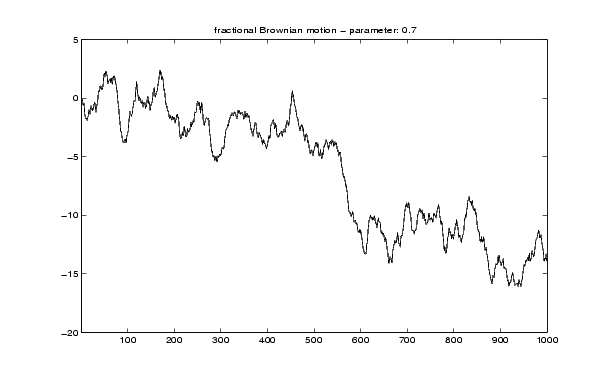

| Wavelet Toolbox |   |
Fractional Brownian motion synthesis
Syntax
FBM = wfbm(H,L) FBM = wfbm(H,L,'plot') FBM = wfbm(H,L,NS,W), FBM = WFBM(H,L,W,NS) wfbm(H,L,'plot',NS,W), WFBM(H,L,'plot',W,NS)
Description
FBM = wfbm(H,L) returns a fractional Brownian motion signal FBM of the Hurst parameter H (0 < H < 1) and length L, following the algorithm proposed by Abry and Sellan.
FBM = wfbm(H,L,'plot') generates and plots the FBM signal.
FBM = wfbm(H,L,NS,W) or FBM = wfbm(H,L,W,NS) returns the FBM using NS reconstruction steps and the sufficiently regular orthogonal wavelet W.
wfbm(H,L,'plot',NS) or wfbm(H,L,'plot',W) or wfbm(H,L,'plot',NS,W) or wfbm(H,L,'plot',W,NS) generates and plots the FBM signal.
wfbm(H,L) is equivalent to WFBM(H,L,6,'db10').
wfbm(H,L,NS) is equivalent to WFBM(H,L,NS,'db10').
wfbm(H,L,W) is equivalent to WFBM(H,L,W,6).
A fractional Brownian motion (fBm) is a continuous-time Gaussian process depending on the Hurst parameter 0 < H < 1. It generalizes the ordinary Brownian motion corresponding to H = 0.5 and whose derivative is the white noise. The fBm is self-similar in distribution and the variance of the increments is given by
where v is a positive constant.
Examples
According to the value of H, the fBm exhibits for H > 0.5, long-range dependence and for H < 0.5, short or intermediate dependence. This example shows each situation using the wfbm M-file, which generates a sample path of this process.
% Generate fBm for H = 0.3 and H = 0.7 % Initialize the randn generator randn('state',1) % Set the parameter H and the sample length H = 0.3; lg = 1000; % Generate and plot wavelet-based fBm for H = 0.3 fBm03 = wfbm(H,lg,'plot');% Reset randn generator and parameter H randn('state',1); H = 0.7; % Generate and plot wavelet-based fBm for H = 0.7 fBm07 = wfbm(H,lg,'plot'); % The last step is equivalent to % Define wavelet and level of decomposition % w = ' db10'; ns = 6; % Generate % fBm07 = wfbm(H,lg,'plot',w,ns);

fBm07 clearly exhibits a stronger low-frequency component and has, locally, less irregular behavior.
Algorithm
Starting from the expression of the fBm process as a fractional integral of the white noise process, the idea of the algorithm is to build a biorthogonal wavelet depending on a given orthogonal one and adapted to the parameter H.
Then the generated sample path is obtained by the reconstruction using the new wavelet starting from a wavelet decomposition at a given level designed as follows: details coefficients are independent random Gaussian realizations and approximation coefficients come from a fractional ARIMA process.
This method was first proposed by Meyer and Sellan and implementation issues were examined by Abry and Sellan.
Nevertheless, the samples generated following this original scheme exhibit too many high-frequency components. To circumvent this undesirable behavior Bardet et al. propose downsampling the obtained sample by a factor 10.
Two internal parameters delta = 10 (the downsampling factor) and a threshold prec = 1E-4, to evaluate series by truncated sums, can be modified by the user for extreme values of H.
A complete overview of long-range dependence process generators is available in Bardet et al.
See Also
References
Abry, P.; F. Sellan (1996), "The wavelet-based synthesis for the fractional Brownian motion proposed by F. Sellan and Y. Meyer: Remarks and fast implementation," Appl. and Comp. Harmonic Anal., 3(4), pp. 377-383.
Bardet, J.-M.; G. Lang, G. Oppenheim, A. Philippe, S. Stoev, M.S. Taqqu (2003), "Generators of long-range dependence processes: a survey," Theory and applications of long-range dependence, Birkhäuser, pp. 579-623.
 | wextend | wfbmesti |  |
© 1994-2005 The MathWorks, Inc.